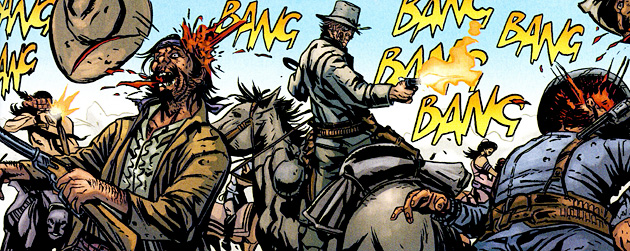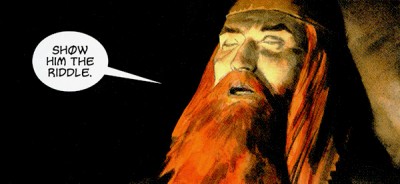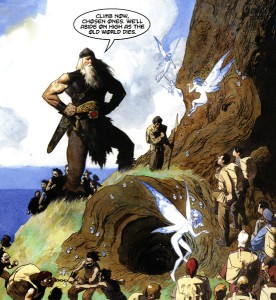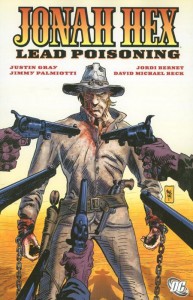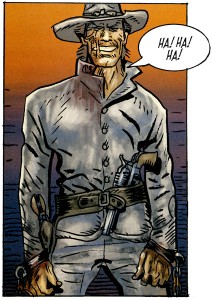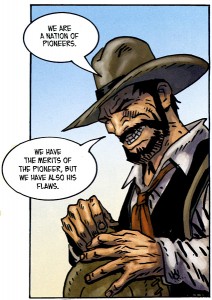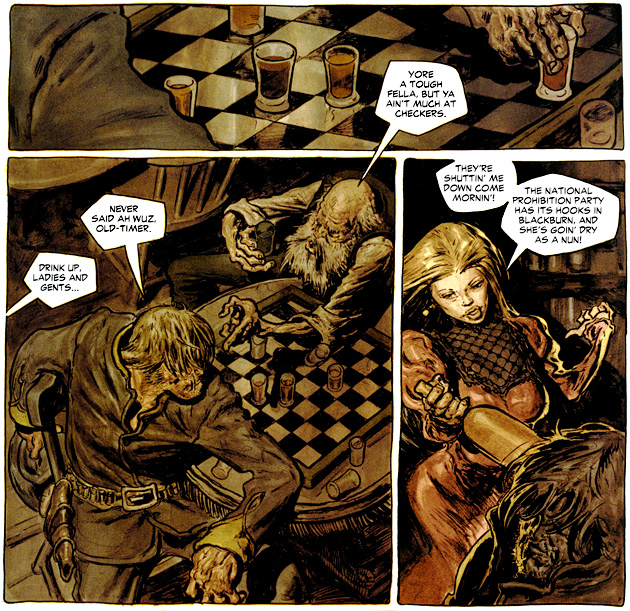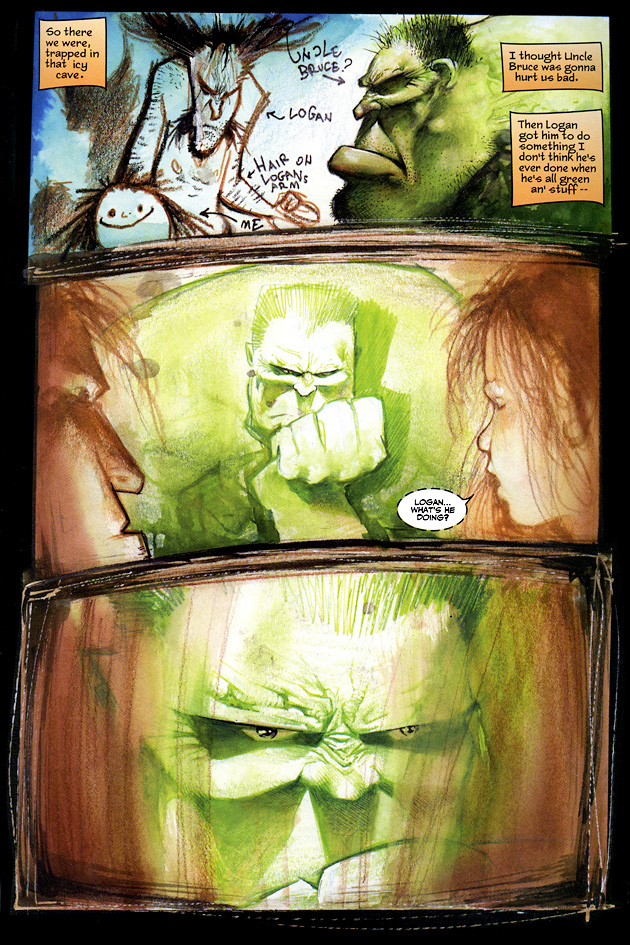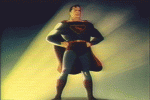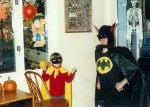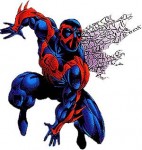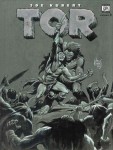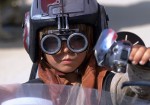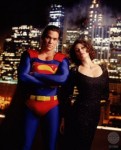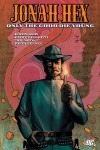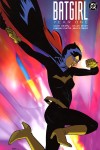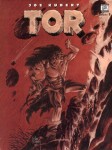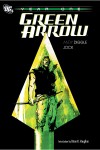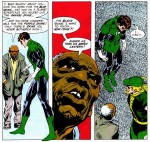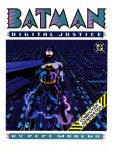 |
|
This review contains minor spoilers. Skip To The Verdict? »
 Jonah Hex prides himself on brevity.
Jonah Hex prides himself on brevity.
Few words and a swift bit of violence to those deserving.
His comic is similar, a rarity among today’s mainstream books.
Most stories are over in an issue, with the longest arc thus far lasting only three.
The Six Gun War, then, seems practically epic, weighing in at 6 full issues for just one storyline.
Similarly, while we’re used to Jimmy Palmiotti and Justin Gray writing every issue, it’s a bit of a surprise to see only one artist.
The newcomer is Cristiano Cucina, who illustrates every page of this trade, including the covers.
After I realized that this would all be one long story, my immediate fear was that it would drag on, losing itself in slow pacing. I was darn wrong.
I’m not sure how the Js did it, but Six Gun didn’t seem any longer than your standard Hex tale (which is both a testament to how much story is packed in a normal issue and to how well paced this book is). Not that it’s a perfect story, but I wanted to assure you from the start that it didn’t feel stretched out.
What we have here is a a bonafide shindig, bringing together almost every major character (that ain’t dead) from Hex lore.
It’s all on account of Quintin Turnbull. We last saw him in Welcome to Paradise (and the Showcase Presents) where he did his best to make life miserable for Hex (since Turnbull blames Jonah for his son’s death.)
Predictably, he’s back at it here. And he’s brought along El Papayago, a horde of his banditos, and plenty of other hired baddies.
Hex, for all his anti-social nature, has his own friends – DC Western heroes El Diablo, Bat Lash, similarly scarred Tallulah Black, and a whole tribe of Comanche, lead by ex-Union soldier Blue Eagle.
There’s even an unexpected appearance by another character from the current run, and with most of those people dead or out to kill Hex, that’s a mixed blessing.
With this cast, it’s not going to come as a surprise that bullets will soon be flying. And while it may not be the most drawn out conflict, but there’s certainly enough of a bodycount to earn the word “War” in the title.
The plot is classic revenge western. Parties have been harmed and they want comeuppance.
Pretty much every party, in this case, and if they haven’t been harmed at the start of the story, they’re in for it.
The straightforward plot is a strength and a bit of a weakness. While the story moves in every direction towards inevitable (and delightful) conflict, there isn’t much else going on either.
It’s like an action movie, good fun, great wisecracking heroes, thoroughly unlikable – if a bit shallow – villains, a plot twist or two (including one I didn’t see coming) and the inevitable explosive ending.
 Except the ending here isn’t exactly what you’d expect either – unless you’re a long time comic reader.
Except the ending here isn’t exactly what you’d expect either – unless you’re a long time comic reader.
In which case, it’s exactly what you were fearing.
Besides that, most of the deeper themes the Hex title has explored on occasion are absent.
Fun comics. Thinking optional, ‘s long as ya can read. I found myself happily turning pages.
The low points are when it falls into action movie cliches – the international roster of assassins called in to kill Hex, for example, feels right out of the 80s.
The high points for me involved the well written involvement of the other DC heroes, particularly Lazarus Lane, and the ongoing evolving character of Tallulah Black – easily the most badass of any of them. The gal deserves her own title.
The cast interacts naturally and their personalities and unique quirks result in some priceless moments.
Cucina carries his share of the weight admirably. His style is a good fit for this violent western, about partway between Hex regular Jordi Bernet‘s stylized cartoons and the more gritty work of Val Semeiks or Hex co-creator Tony DeZuniga. While there’s still heavy use of bold inking, it’s a bit more realistic.
The characters have the appropriate amount of grit and grimace to their faces and Hex looks nasty as ever. The baddies have been given a fair amount of attention and I thoroughly enjoyed any of El Diablo’s flaming appearances.
I did feel like Bat Lash looks a bit odd. My main complaint had to do with the difficulty in telling him apart from Hex in some of the more hectic scenes, or at certain angles.
 On the whole, the art is detailed and distinct. The action is of the quality I’ve come to expect from this title and even the slower scenes are crafted with admirable attention.
On the whole, the art is detailed and distinct. The action is of the quality I’ve come to expect from this title and even the slower scenes are crafted with admirable attention.
It may not be of an individual style that I could point out in a lineup, but it does the job quite well here, allowing the story to flow smoothly.
The Six Gun War is a welcome addition to the Hex mythos – I’m always glad to see these western types working together.
The only true shame is that it feels a bit like the middle entry in a trilogy of action movies, produced to cater to fan desires, but leaving more than enough room for events to come.
I can see this being a bit disappointing to those looking for a solid conclusion to the Turnbull story.
If the writers have something up their sleeve for the next volume, I say bring it on.
Verdict:
4 out of 5. It’s a solid action movie style story. It drags you along through some riotous violence, and probably fills fans desires for a bigger western story.
While it’s not much deeper than that, there’s plenty to enjoy for those who have been following Hex’s adventures.
Essential Continuity:
This book is probably essential – it’s the next chapter of the story, connecting all the way back to Hex’s early adventures.
There’s a little retelling of Hex’s involvement with Turnbull’s son and it’s not too different from the version in the Bronze Age collections (though I like that one better, the differences between Hex then and Hex “now” shows character growth.)
Of course, any DC Western title only has minimal effect on the rest of the DCU continuity (though the characters do tie in, I promise!)
Read first:
You definitely have to read Showcase Presents Jonah Hex and/or Jonah Hex: Welcome to Paradise. Paradise contains the condensed version and a little more, but it’s an introduction to the villain of this story.
The contemporary series has been collected in Jonah Hex: Face Full of Violence, Jonah Hex: Guns of Vengeance, Jonah Hex: Origins, Jonah Hex: Only The Good Die Young, Jonah Hex: Luck Runs Out, Jonah Hex: Bullets Don’t Lie, and Jonah Hex: Lead Poisoning.
It’s light on continuity though, so if you’re in a hurry I’d recommend Vengeance, Origins, and then Luck Runs out to catch you up – but the last story in Only The Good Die Young is also an enjoyable crossover.
Finally, in order to get the most of it, you’ll want to at least read Showcase Presents: Bat Lash.
Read next:
Following along with the DC Comics Reading Order, the DC Westerns and Jonah Hex‘s own list, the next book will be Jonah Hex: Counting Corpses.
My copy is in the mail, so I hope it gets here soon!





